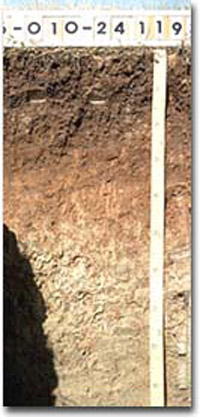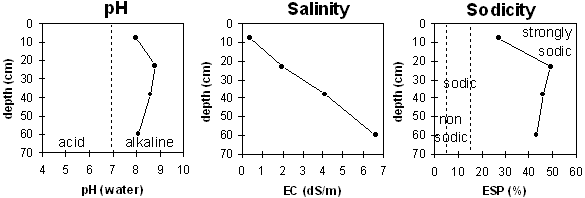WP1
| Location: Morton Plains. | Australian Soil Classification: Episodic-Epicalcareous, Epipedal, Brown VERTOSOL. |
| Northcote Factual Key: Ug 5.35. | Great Soil Group: brown clay. |
| General Landscape Description: Extensive plain. |
Soil Profile Morphology:
Surface Soil
| A1 | 0-15 cm | Strong brown (7.5YR4/6); medium clay; moderate prismatic, breaking down to strong coarse blocky structure; strong consistence dry; pH 8.0; sharp change to: |
 Site WP1 Profile |
| Subsoil | |||
| B21 | 15-30 cm | Strong brown (7.5YR5/6); medium heavy clay; very firm consistence dry; pH 8.8; gradual change to: | |
| B22 | 30-45 cm | Reddish yellow (7.5YR6/6); light medium clay; gradual change to: | |
| B31 | 45-75 cm | Pinkish grey (7.5YR7/2); medium clay; moderate prismatic, breaking down to blocky structure; very firm consistence dry; contains many (20-50%) soft carbonates; pH 8.6; gradual change to: | |
| B32 | 75-150 cm | Light brownish grey (2.5YR6/2); medium heavy clay; prismatic structure (smooth faced peds); strong consistence dry; pH 8.1. | |
pH | Salinity | |||
Surface (A1 horizon) | moderately alkaline | very low | strongly sodic | strong |
Subsoil (B21 horizon) | strongly alkaline | extremely high | extremely sodic | strong |
Deeper subsoil (at 60 cm) | moderately alkaline | extremely high | extremely sodic | none1 |

Horizon | Horizon Depth (cm) | pH (water) | pH (CaCl2) | EC 1:5 | Exchangeable Cations | NaCl % | Field Capacity pF 2.5 | Wilting Point pF 4.2 | |||
Ca | Mg | K | Na | ||||||||
meq/100g | |||||||||||
A1 | 0-15 | 8.0 | 7.2 | 0.38 | 8.4 | 5.7 | 1.0 | 5.5 | 0.06 | 33 | 24 |
B21 | 15-30 | 8.8 | 8.4 | 1.98 | 6.3 | 7.8 | 1.1 | 14.5 | 0.41 | 47 | 30 |
B22 | 30-45 | 8.6 | 8.4 | 4.12 | 8.7 | 9 | 1.2 | 16.2 | 0.9 | ||
B23 | 45-75 | 8.1 | 8.0 | 6.63 | 11.8 | 11.1 | 1.2 | 18.4 | 1.16 | ||
Management Considerations:
Surface (A) Horizon
- The surface soil is strongly sodic and likely to be responsive to gypsum application. Infiltration of water is likely to be slow and surface crusting may occur if soil is exposed to raindrop impact.
- The high wilting point value (i.e. 24%) indicates that plants will be unable to utilise light rains when the soil is relatively dry.
- Tillage, trafficking or over-stocking should be avoided if the soil is wet (i.e. wetter than the plastic limit). At such moisture conditions, these activities could result in structural damage (e.g. compaction, smearing) occurring. Ideally, trafficking should take place when the soil is drier than the plastic limit, down to at least the tillage depth.
- Soluble salt levels are extremely high in the subsoil and are likely to restrict the growth of many salt sensitive species.
- The subsoil is extremely sodic which will result in restricted root and water movement. Adverse chemical imbalances may also occur as well as possible toxic effects for some plants.
- The upper subsoil is strongly alkaline. This indicates that certain nutrients (e.g. iron, manganese, zinc and boron) may be poorly available to plants.


